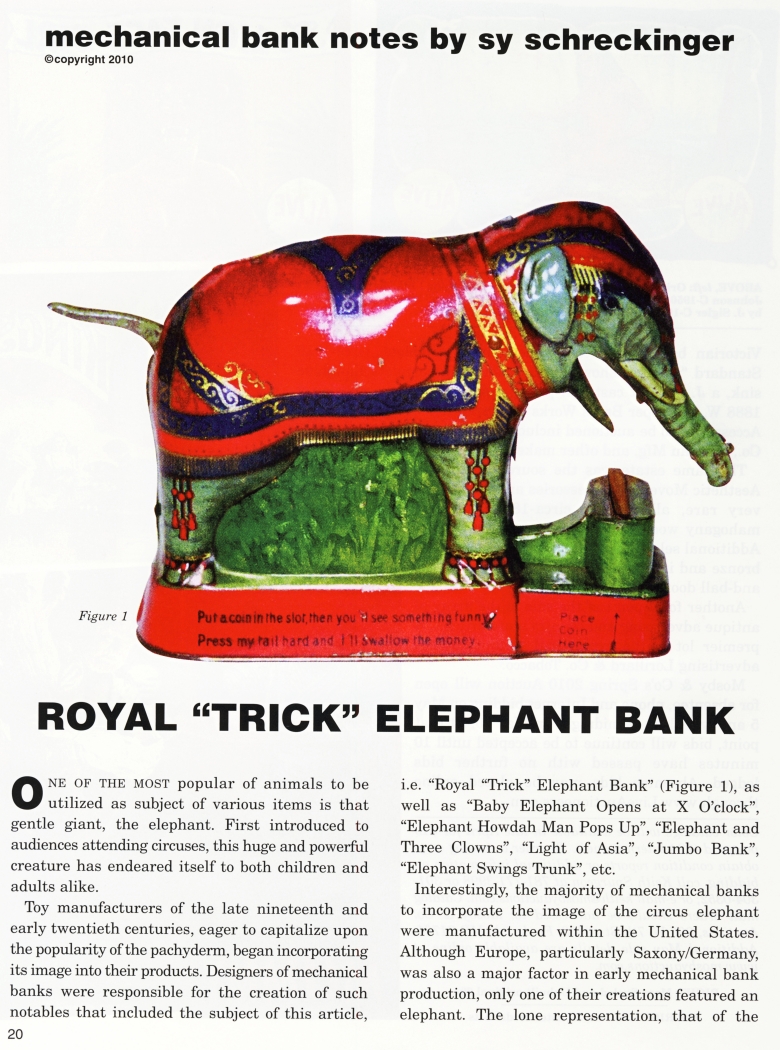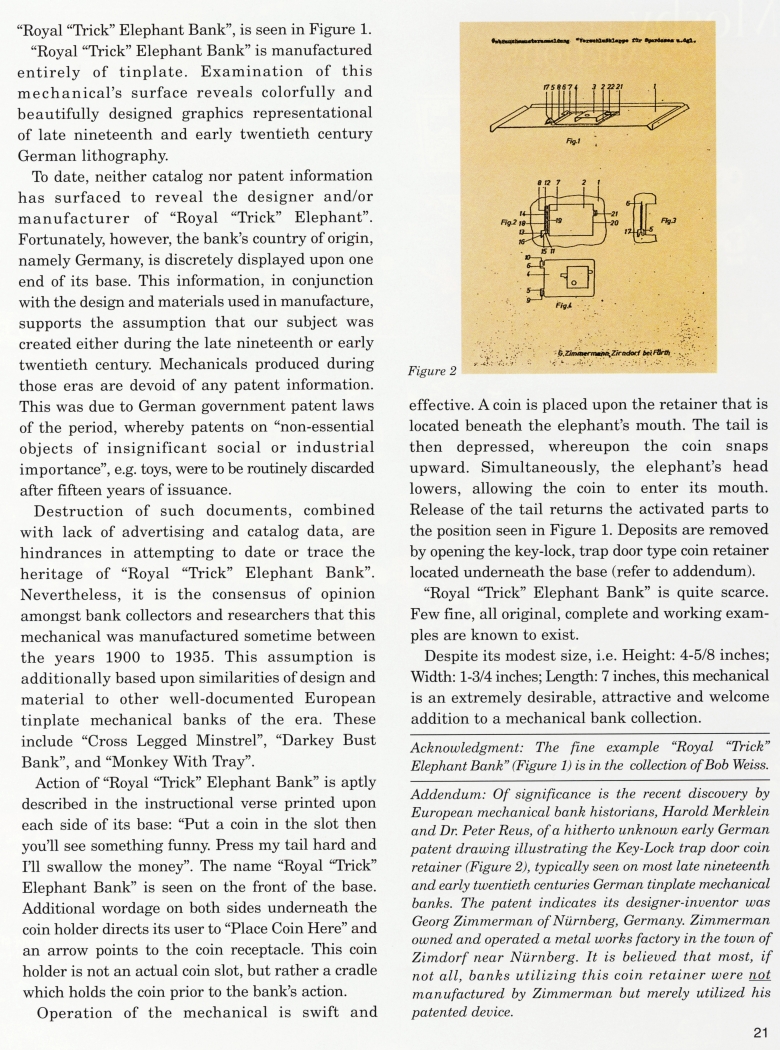|
Royal "Trick" Elephant Bank
by Sy Schreckinger – ANTIQUE TOY WORLD Magazine – May, 2010
ONE OF
THE MOST popular of animals to be utilized as subject of various items
is that
gentle giant, the elephant. First introduced to audiences attending
circuses, this huge and powerful creature has endeared itself to both
children and adults alike.
Toy manufacturers of the late nineteenth and early twentieth centuries,
eager to capitalize upon the popularity of the pachyderm, began
incorporating its image into their products. Designers of mechanical
banks were responsible for the creation of such notables that included
the subject of this article,
i.e. "Royal "Trick" Elephant Bank" (Figure 1), as well as "Baby Elephant
Opens at X O'clock", "Elephant Howdah Man Pops Up", "Elephant and Three
Clowns", "Light of Asia", "Jumbo Bank", "Elephant Swings Trunk", etc.
Interestingly, the majority of mechanical banks to incorporate the image
of the circus elephant were manufactured within the United States.
Although Europe, particularly Saxony/Germany, was also a major factor in
early mechanical bank production, only one of their creations featured
an elephant. The lone representation, that of the
"Royal "Trick" Elephant Bank", is seen in Figure 1.
"Royal "Trick" Elephant Bank" is manufactured entirely of tinplate.
Examination of this mechanical's surface reveals colorfully and
beautifully designed graphics representational of late nineteenth and
early twentieth century German lithography.
To date, neither catalog nor patent information has surfaced to reveal
the designer and/or manufacturer of "Royal "Trick" Elephant".
Fortunately, however, the bank's country of origin, namely Germany, is
discretely displayed upon one end of its base. This information, in
conjunction with the design and materials used in manufacture, supports
the assumption that our subject was created either during the late
nineteenth or early twentieth century. Mechanicals produced during those
eras are devoid of any patent information. This was due to German
government patent laws of the period, whereby patents on "non-essential
objects of insignificant social or industrial importance", e.g. toys,
were to be routinely discarded after fifteen years of issuance.
Destruction of such documents, combined with lack of advertising and
catalog data, are hindrances in attempting to date or trace the heritage
of "Royal "Trick" Elephant Bank". Nevertheless, it is the consensus of
opinion amongst bank collectors and researchers that this mechanical was
manufactured sometime between the years 1900 to 1935. This assumption is
additionally based upon similarities of design and material to other
well-documented European tinplate mechanical banks of the era. These
include "Cross Legged Minstrel", "Darkey Bust Bank", and "Monkey With
Tray".
Action of "Royal "Trick" Elephant Bank" is aptly described in the
instructional verse printed upon each side of its base: "Put a coin in
the slot then you'll see something funny. Press my tail hard and I'll
swallow the money". The name "Royal 'Trick" Elephant Bank" is seen on
the front of the base. Additional wordage on both sides underneath the
coin holder directs its user to "Place Coin Here" and an arrow points to
the coin receptacle. This coin holder is not an actual coin slot, but
rather a cradle which holds the coin prior to the bank's action.
Operation of the mechanical is swift and
effective. A coin is placed upon the retainer that is located beneath
the elephant's mouth. The tail is then depressed, whereupon the coin
snaps upward. Simultaneously, the elephant's head lowers, allowing the
coin to enter its mouth. Release of the tail returns the activated parts
to the position seen in Figure 1. Deposits are removed by opening the
key-lock, trap door type coin retainer located underneath the base
(refer to addendum).
"Royal "Trick" Elephant Bank" is quite scarce. Few fine, all original,
complete and working examples are known to exist.
Despite its modest size, i.e. Height: 4-5/8 inches; Width: 1-3/4 inches;
Length: 7 inches, this mechanical is an extremely desirable, attractive
and welcome addition to a mechanical bank collection.
Acknowledgment: The fine example "Royal "Thick" Elephant Bank" (Figure
1) is in the collection of Bob Weiss.
Addendum: Of significance is the recent discovery by European mechanical
bank historians, Harold Merklein and Dr. Peter Reus, of a hitherto
unknown early German patent drawing illustrating the Key-Lock trap door
coin retainer (Figure 2), typically seen on most late nineteenth and
early twentieth centuries German tinplate mechanical banks. The patent
indicates its designer-inventor was Georg Zimmerman of Niirnberg,
Germany. Zimmerman owned and operated a metal works factory in the town
of Zimdorf near Niirnberg. It is believed that most, if not all, banks
utilizing this coin retainer were not manufactured by Zimmerman but
merely utilized his patented device.
|

